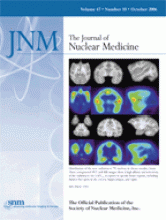TO THE EDITOR: We read with great interest the paper by Nishina et al. (1). The authors concluded from their study that, compared with supine MPS alone, combined supine–prone quantification significantly improves the specificity of myocardial perfusion scintigraphy (MPS) in the identification of obstructive coronary artery disease. Supine acquisition is known to result in diaphragmatic attenuation of inferior wall counts. In our limited experience using the combined supine–prone imaging method, we achieved results similar to those of Nishina et al. indicating that the specificity of MPS for perfusion abnormalities in the posterior wall of the myocardium can be improved. However, we emphasize that in many patients with “true” perfusion abnormalities, cardiac symptoms develop during the stress procedure and—not only in these patients but also in obese patients—the additional prone positioning may be quite inconvenient. Therefore, with the growing number of new devices enabling attenuation correction by means of CT, we suggest that combined SPECT/CT be preferred to the combined supine–prone protocol to improve the specificity of MPS in routine clinical workups (2–4).







